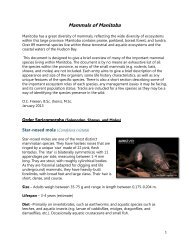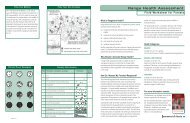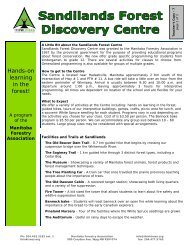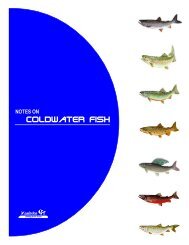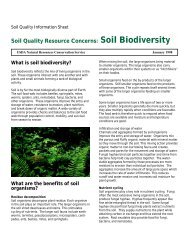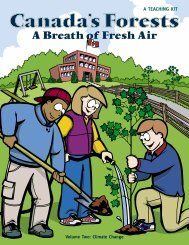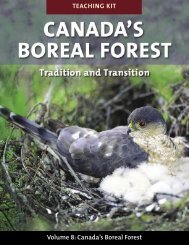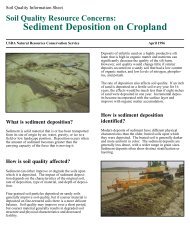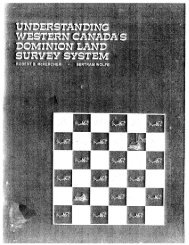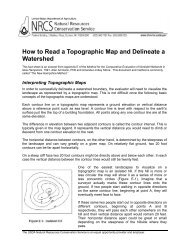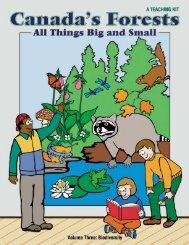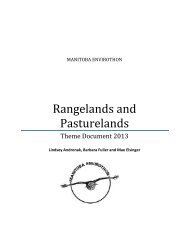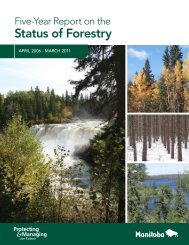Volume 6 - Canadian Forestry Association
Volume 6 - Canadian Forestry Association
Volume 6 - Canadian Forestry Association
- No tags were found...
You also want an ePaper? Increase the reach of your titles
YUMPU automatically turns print PDFs into web optimized ePapers that Google loves.
TEACHING KIT<strong>Volume</strong> 6: Forests and Water
Manitoba to HostEnvirothon 2006Water Stewardship in a Changing ClimateThe Manitoba <strong>Forestry</strong> <strong>Association</strong> will host the 2006 CanonNorth American Envirothon in Winnipeg MB, from July 23to 29. Canon Envirothon is a weeklong competition amongwinning provincial/state teams from across North America.The competition tests five general themes including: Soilsand Land Use, Aquatic Ecology, <strong>Forestry</strong>, Wildlife and acurrent Environmental Study issue, which for 2006 is:Water Stewardship in a Changing Climate.Established in 1919 as the Manitoba arm of the CFA,the Manitoba <strong>Forestry</strong> <strong>Association</strong> has a long historyin innovative forest education. For over fifty years, theCFA Railroad Classroom and Conservation cars toured across thePrairie Provinces under the direction of the late Alan Beaven.The last car was retired in 1973.For more information about theCanon Envirothon near you, visit:www.envirothon.orgFor more information about theCanon North American Envirothon 2006:jpotton@mts.netAt least 30% of the fibre used inmanufacturing the paperboard forthis cover comes from well-managedforests independently certified inaccordance with the rules of theForest Stewardship Council.30%MinimumSW-COC-551FSC Trademark © 1996 Forest Stewardship Council A.C.
ContentsCanada’s Forests and Wetlands – Our Natural Water Filters explores forest,wetland and water issues in Canada and around the world. These lessons aredesigned to provide young <strong>Canadian</strong>s with a wide variety of learning opportunitiessuitable for all age levels in every classroom, from special needs to gifted andESL. Curriculum topics encompass Science, World Issues, Geography, CareerStudies, Civics, Visual Arts, English and Drama. This kit also features a posterpromoting the next CFA teaching kit: The Boreal Forest – A Global Legacy.2 Using This Teaching Kit3 Canada’s Forests, Wetlands and Freshwater5 How is Water Used in Canada?6 How Can We Help?7 Canada’s Forests and Wetlands Teaching Resources11 Lesson 1: Forest Flora and Fauna (ages 5 to 9)14 Lesson 2: All Systems Go! (ages 5 to 9)17 Lesson 3: What’s Your Perspective? (ages 10 to 13)19 Lesson 4: Changes and Choices (ages 10 to 15)24 Lesson 5: Creating a Forest Code of Conduct (ages 12 to 18)26 Lesson 6: Trees, Water and Peace (ages 16 to 18)30 Lesson 7: What Water Source is Best? (ages 16 to 18)33 Lesson 8: Tell Me a Story (ages 12 to 18)37 Glossary38 CFA Programs39 CFA Partner Agencies© 2005 <strong>Canadian</strong> <strong>Forestry</strong> <strong>Association</strong>ISBN 0-9737807-0-3Project Manager: Dave LemkayProject Coordinator: The Professional EdgeEditor: Treena HeinWriters: Treena Hein and Nancy RandallIllustration & Design: Design HouseFrench Translation: Le réseau multicomCover Stock: Kalima Coated, donated by Tembec Inc.Printed and Bound in Canada by: PSI Print Solutions Inc.Cover Photo: Clayton RallinsThe CFA is dedicated to the wise useand conservation of Canada’s forest,water and wildlife resources throughenhanced public awareness andeducation programs. The CFATeaching Kit Series provides educatorswith the tools to help young peoplebetter understand the value of forestsand the importance of protecting andconserving them.Canada’s forests play a vital role inmaintaining and protecting ourfreshwater resources. Effective policiesand management practices for our forestsand wetlands are key.The CFA has made every effort toprovide a balanced perspective onthe interests and activities of forestprofessionals, biologists, landowners,Aboriginal people, rural and urbancitizens, environmental groups,agriculture and industry focusing on acommon goal: the thoughtful use andmanagement of Canada’s preciousfreshwater, wetland and forest resources.These people, who tend to be dedicatedconservationists by nature, are not oftenfeatured in the media or recognizedfor their efforts. However, they areresponsible for a tremendous amount ofvaluable ground-level work includingtree planting, habitat conservation,management planning, and publicoutreach and education. The CFAdedicates this kit to them.
Using This Teaching KitThis teaching kit, the sixth in theCanada’s Forest teaching kit series, isrecommended for nationwide use byclassroom educators and youth leaders.It is designed to help teachers andstudents explore the important role ofCanada’s forests in sustaining ourfreshwater resources.The background information containsanswers to common questions aboutforests and freshwater, as well as manyuseful and current statistics. Numerousteaching resources are also included foryour convenience.Target AudienceSince Canada’s provinces and territoriesuse various grade specifications andterminologies (such as primary andintermediate) we have indicated onlythe broad age groups and commonly usedlevels for each lesson. Some activitiescan be used with several age groups.Keygroup activityCurriculum LinksThe lessons in this kit are designed to meet the curricula of many differentgrades and courses across Canada, including Science, World Issues, Geography,Career Studies, Civics, Visual Arts, English and Drama. Each lesson includesone broad Learning Outcomes describing what students will demonstrate duringthe activity. Outcomes can be easily expanded to fit curriculum needs.Flexible and Easy-To-Use ActivitiesTo stimulate teacher and student creativity and engagement in the learningprocess, this kit includes various hooks – attention-grabbing lesson openers –and extension options.Web ResourcesVisit the <strong>Canadian</strong> <strong>Forestry</strong> <strong>Association</strong> Web site, www.canadianforestry.com,for supplementary lessons featuring Canada’s forests and freshwater. Whileonline, download lessons from previous teaching kits on a wide variety of foresttopics including forest heritage, climate change and species at risk.In particular, please note the water filtering activity from <strong>Volume</strong> 4 onSustainable Forests: Water, Water Everywhere! This lesson has students usinghousehold materials to create their own experimental filtering models todemonstrate how trees and other plants filter water and slow sedimentation.Contact UsTo order teaching kits or provide feedback, please contact the <strong>Canadian</strong> <strong>Forestry</strong><strong>Association</strong> at www.canadianforestry.com/html/education/cfa_kits_e.html.We look forward to hearing from you.presentation/performance activitywriting/recording activityresearch-based activityextensionshookWhile the CFA grants permissionfor the photocopying of this entirepublication, the pages marked withthe photocopier icon are designedspecifically as student worksheets.2 <strong>Canadian</strong> <strong>Forestry</strong> <strong>Association</strong> Teaching Kit
Canada’s Forests, Wetlands and FreshwaterWhy is Freshwater Important?All living things depend on water. Wet habitats provide a permanent homefor dozens of species of fish, insects, reptiles, amphibians, birds and mammals.Others use them frequently for feeding, reproduction, migration stops andmore. Trees and other vegetation found in the water and near the water’s edge– riparian zones – provide wildlife with necessary shade, shelter, nourishmentand hiding places.People cannot live more than a few days without water. We need it to drink,cook and clean, manufacture and transport goods, farm crops, raise livestock,and enjoy in a variety of recreational pursuits.How Are Canada’s Forests Important in Sustaining Freshwater?Trees and other vegetation are very important for minimizing and preventingerosion and sedimentation around our streams, rivers, lakes and wetlandsbecause their extensive root systems hold the soil in place. Roots also counterthe effects of soil compaction in that they constantly push through and aeratethe soil, allowing rain and melt-water to penetrate the earth and be filteredby microorganisms before reaching the water table below.By retaining toxins and nutrients such as mercury and phosphorus, forestsoils prevent a portion of these substances from entering streams and groundwater.They also regulate water taste, clarity and colour, and water chemistryfactors such as acidity.Wetlands play an even greater role in water filtering because they contain manymore microorganisms than are found in forest soils. As well, they remove or trapsediments, harmful bacteria and excess nitrogen.Many <strong>Canadian</strong> organizations and corporations are currently using constructedwetlands to cleanse wastewater and sewage. These include the University ofOttawa and The Body Shoppe in Toronto ON, the city of Humbolt SK, andthe Oak Hammock Marsh Interpretive Centre in Stonewall MB.Forests and wetlands also play a role in maintaining steady water table levels byabsorbing excess run-off. As part of the water cycle, trees and other plants filterwater by absorbing it from the soil then expelling some into the air through transpiration.Plants use water during photosynthesis, the process of creating energyfrom using the sun’s light, and emit oxygen to the atmosphere, which animalsuse to process the food energy they consume. Photosynthesis in forests involvesthe absorption of great amounts of carbon dioxide, a greenhouse gas involvedin climate change. Forests thus comprise a vast and important carbon sink.Freshwater StatisticsWorld population: 6 billion+Number of people currently without accessto clean drinking water: 1 billion+Year this number will most likely reachfour billion people: 2025Increase in amount of water used per personcompared to a century ago: 6 timesAmount of water needed to replenish our bodiesevery day through drinking and eating: 2.4 litresNumber of people who die each year fromdiseases caused by unsafe drinking water, lackof sanitation and insufficient water for hygiene:about 3.4 millionPortion of water-related illnesses indeveloping countries: 80%How Much Water is Requiredto Produce:x 1000 =x 324 =x 99 980 =1 kg of potatoes1 kg of paper1 kg of beef<strong>Canadian</strong> <strong>Forestry</strong> <strong>Association</strong> Teaching Kit 3
The Role of Treesin the Water Cycle4 <strong>Canadian</strong> <strong>Forestry</strong> <strong>Association</strong> Teaching Kit
How is Water Used in Canada?Who Cares for Canada’s Forests and Wetlands?The majority of Canada’s forests and wetlands are located on Crown land:77 per cent are held by a province or territory, 16 per cent are federally held,and 7 per cent are privately owned. In most other countries, the vast majorityof forests and wetlands are privately owned. In this respect, all <strong>Canadian</strong>shave a unique privilege and responsibility to act as stewards for our forests andfreshwater. We vote for governments at municipal/band council, provincial/territorial and federal levels to make decisions about Canada’s natural resourceson our behalf, but we are also free to express our views and participate ingovernment decision-making at any time.How Does Canada’s Water Use Compare?Canada ranks 28 among the 29 member nations of the Organisation forEconomic Co-operation and Development (OECD) in terms of per capitawater consumption, and 26 in terms of total consumption. Canada uses 1600cubic metres of water per person per year. This is more than twice as much wateras the average French citizen, three times as much as the average German, andalmost four times as much as the average Swede.What Does Clean Water Cost?<strong>Canadian</strong>s pay little for our water compared to people in other countries. In1999, the average cost of municipal water was $0.96 per cubic metre and themonthly water and sewage bill for the average <strong>Canadian</strong> household was $28.56.This is at the low end of OECD countries.Citizens of British Columbia and Newfoundland/Labrador enjoy the lowestwater costs in Canada. Both provinces have abundant supplies, many gravity-fedsystems, and generally good water quality, requiring less treatment. The highestpriced water is on the Prairies where water shortages can occur, and in theTerritories where permafrost and other climate conditions negatively impactwater supplies.How Much Water Does a Tree Absorb vs. Release?This process is dependent on many factors, such as tree species, the amount ofwater available in the soil, and most of all, the weather. On a hot, dry day, a treewill transpire the greatest amount, but will stop the process by shutting its tinystomata (spaces between leaf and/or stem surface cells) to halt water loss if soilmoisture drops too low. Various tree species have adapted over millions of yearsto thrive in conditions ranging from constantly saturated to very dry soil.What is the Extent of Canada’sFreshwater and Wetlands?Portion of the world's freshwater found withinCanada's borders: 20%Portion of the world's renewable freshwater(water that is not retained in lakes, undergroundaquifers and glaciers) in Canada: 7%Portion of Canada’s total area covered byfreshwater: almost 9% or 891 163 square kmCountry with the most wetlands: CanadaCanada’s share of the world's wetlands: 25%Industrial Water Use in Canada?14%Manufacturingindustries1%Mining64%Thermalpower generation9%AgricultureHow is Water Used in Our Home?On average, <strong>Canadian</strong>s use 343 litres of waterper person per day in the home:Bathing 35%Toilet 30%Laundry 20%Kitchen/drinking 10%Cleaning 5%<strong>Canadian</strong> <strong>Forestry</strong> <strong>Association</strong> Teaching Kit 5
How Can We Help?ThreatsMany types of pollution affect our forestfiltering system and the quality of waterin our lakes, rivers, streams, wetlandsand aquifers. Canada’s forests andwetlands must also be protected fromerosion, dredging, filling, outdatedcropping, forest harvesting and fossilfuel exploration practices. Additionalthreats include:- removal of surrounding vegetation,- dumping of any kind,- draining for the creation of farm land,- harvesting peat moss,- shoreline destruction,- climate change, and- invasive construction of transportationand energy transmission corridors.Is Our Freshwater For Sale?Canada is very fortunate to have anabundance of freshwater; as a result,many <strong>Canadian</strong> companies sell bottledwater nationally and abroad. However,opinions vary as to whether or not weshould permit selling our freshwater ingreat quantities. Currently there is nolaw, nor has there ever been one, thatwould prevent the federal governmentfrom deciding to sell <strong>Canadian</strong>freshwater in bulk.To learn more visit the <strong>Canadian</strong>Bottled Water <strong>Association</strong> Web site:www.cbwa-bottledwater.org/en/industry.htmWe Can Each Do Our PartWe can all help to conserve and protect Canada’s forest and water resources:- plant more trees- garden with drought-tolerant and/or native plants- collect rainwater for watering- protect riparian zones- use canoes, kayaks and other people-powered watercrafts rather than motorizedwatercraft- buy from environmentally-friendly companies- use a small amount of water in a glass to brush your teeth rather than runningthe tap- limit yourself to taking three-minute showers.For more water conservation tips visit:www.frugalfun.com/lowerwaterbills.htmlwww.innerself.com/Environmental/world.htm.6 <strong>Canadian</strong> <strong>Forestry</strong> <strong>Association</strong> Teaching Kit
Teaching Resourceswww.wetkit.netNorth American Wetland Conservation CouncilSelect Tools, then Sector, and then Education. At the right, under For MoreInformation, choose the province/territory of your choice. Bog Ho! is anexample of an international Web-based learning project that brings togetherprimary schools from several countries to explore the importance andfragility of wetland habitats. This 2001 project engaged schools in Calgary,New York State and England, enabling students to share data, ask questionsof experts, and participate in discussions. Visit the site to see the students’work, or to find out how your school can get involved.www.swa.caProject WET (Water Education for Teachers)Discover a wide variety of activities for grades K-12, produced by theSaskatchewan Water Authority; select Education.www.livingbywater.caInformation on all things related to freshwater and marine shorelines,including a handbook, impact assessment worksheets, links to educationalresources and more.www.ducks.caDucks Unlimited CanadaIncludes maps, diagrams and lessons. The Resources for You sectionincludes:• Ask the Expert: post your wetland questions• How Does a Wetland Work?: explanation and great diagram of a wetland:aquatic, riparian and upland zones labeled with many plant species• How Wetlands Keep Our Water Clean: explanation and watershed diagram• Interactive North American Duck Migration Maps: by province, with statistics.Also includes free teacher resources and student kits in English and Frenchto order, recommendations about Natural Capital and Ecological Goods andServices, and information on classroom programs.www.epals.comAn online classroom community that invites you to link with classroomsthroughout Canada and the world.www.nationalgeographic.comNational GeographicThis site includes a wide variety of maps and lessons; under Map Machine,see map Global Agricultural Threats to the Environment. Select EducatorsHomepage for lessons on the importance of forests and wetlands.www.tbs-sct.gc.ca/Treasury Board of CanadaTo search for contaminated land and water sites by province/territory orelectoral district, select Navigate by Topic A-Z and then Contamination.www.microbeworld.orgThe American Society for MicrobiologyHands-on activities designed for junior/intermediate students on bacterialactivity in soils from ponds, forests, gardens, etc.; can be adapted to anyage group. Select More About Microbes, then MicrobeWorld Activities,then Biosphere in a Bottle.www.cbc.ca/news//background/waterwww.cbc.ca/fifth/deadinthewater<strong>Canadian</strong> Broadcasting CorporationExtensive water facts and statistics including residential water use, globalwater supplies, drinking water treatment and the contamination ofWalkerton's water system.Comparison of Canada's forestry and water resources management practicesversus those of other countries.www.ec.gc.ca/water/e_main.htmlEnvironment CanadaOver 150 freshwater facts for Canada and the world; select InformationalResources and Services on the main menu, then Teacher’s Corner, thenFreshwater Facts for Canada; you can download:• Every Drop Counts: A Speaker’s Kit on Water Conservation and Efficiency:a PowerPoint presentation• Explore Water With Holly Heron and From the Mountains to the Sea: AJourney in Environmental Citizenship: activity books for primary/juniorstudents• Let’s Not Take Water for Granted: Kids WaterFest at the Museum ofIndustry, Stellarton NS: resource kit with teaching suggestions, readingmaterial and activities• A Primer on Fresh Water: Questions and Answers: for senior students,explores a wide range of facts on various aspects of water• Water and Canada: Preserving a Legacy for People and the Environment:booklet prepared in connection with The Third World Water Forum held inJapan, 2003.Also visit Quickfacts in the sidebar.http://atlas.gc.ca/site/index.htmlThe Atlas of Canada, Natural Resources CanadaThis site provides learning resources and maps including data on coastlines,lakes, rivers, waterfalls, land and freshwater areas; select Facts about Canadain the left margin. There are sections on Freshwater (maps showingdrainage, wetlands, groundwater), Environment (forests, hydrology, sea ice,)as well as lesson plans and facts. A search for maps using keyword “rivers”produced 71 maps!www.careercruising.comCareer CruisingInformation on jobs in forestry, wetland and water management.www.jobfutures.caGovernment of CanadaA career planning tool with information about 226 occupational groups anddescriptions of work experiences.www.canadianforestry.com<strong>Canadian</strong> <strong>Forestry</strong> <strong>Association</strong>Information on careers in resource management; select Forest Education,then The Profession.<strong>Canadian</strong> <strong>Forestry</strong> <strong>Association</strong> Teaching Kit 7
www.canadian-forests.com/job.html<strong>Canadian</strong> ForestsA Web site on forests and forestry in Canada including links to all federal andprovincial governments, the forest industries, service and supply companies,associations and NGOs, consultants, education and research, forestry news,and employment opportunities.www.cif-ifc.org<strong>Canadian</strong> Institute of <strong>Forestry</strong>Information about forestry policy, practices and career opportunities; forcareer information select Professional Development, then EmploymentOpportunities.www.atl.cfs.nrcan.gc.ca/index-e/index-e.htmlNatural Resources Canada – <strong>Canadian</strong> Forest ServiceInformation about careers in science including research, forestry, biology,GIS specialist and communications; in the sidebar select Science, thenCareers in Science.www.envirothon.orgCanon EnvirothonAn annual competition among state/provincial teams of students grades 9to 12 for recognition and scholarships. Teams demonstrate knowledge ofenvironmental science and natural resource management through hands-onproblem-solving activities. There are four testing categories (soils/land use,aquatic ecology, forestry, and wildlife) in addition to a current environmentalissue. The site provides history about the competition, how to enter a team,training resources, etc. Recent results are posted on the <strong>Canadian</strong> <strong>Forestry</strong><strong>Association</strong> Web site: www.canadianforestry.com.www.modelforests.net<strong>Canadian</strong> Model Forest NetworkA program of the <strong>Canadian</strong> Forest Service, this site has information onconservation projects, international model forest partnerships, Aboriginalinitiatives, and Local Level Indicators, which are the heart of the modelforests’ emphasis on sustainability. These indicators “provide the frameworkfor monitoring on-the-ground changes and assessing their influence on themany components of sustainable forest management.”www.waterontheweb.orgWater on the WebA research site for senior students and their teachers including how to studya water problem, design experiments, analyze and present data; independentmodules. In the main menu select Curricula, then Teaching for advancedlessons on topics such as heat budgets of lakes, water conductivity, thermalstratification.www.nrcan-rncan.gc.ca/kids/index_e.htmlNatural Resources Canada Scratching Post for teachers, parents and kids.Students can send e-card tips, play games and complete four quizzes (TheGreat <strong>Canadian</strong> Forest Challenge). For teachers/parents: many links and anupcoming teaching kit.www.green-street.caGreen StreetNumerous all-<strong>Canadian</strong> teaching kits, activities, and games for grades K-12,funded by the J.W. McConnell Foundation, a private grant-making organizationwith a mission “to enhance the ability of <strong>Canadian</strong>s to understand, adaptand respond creatively to the underlying forces that are transforming<strong>Canadian</strong> society and the world.”www.on.ec.gc.ca/greatlakeskids/intro.htmlGreat Lakes KidsThis site features video clips, a colouring book, quizzes, games and activities.www.great-lakes.netGreat Lakes Information NetworkFor information on Great Lakes water level fluctuations (effects, historicallevels, how levels/flow are measured) fish and native flora, GIS maps,economic benefits; select Education.Also check out Environment Canada’s Our Great Lakes Web site:www.on.ec.gc.ca/water/greatlakes/intro-e.html.www.eman-rese.caEcological Monitoring and Assessment NetworkWho’s monitoring Canada’s forests and water? Environment Canada’sEcological Monitoring and Assessment Network is a blanket organization forgroups such as Icewatch, Frogwatch, Plantwatch and yes, even Wormwatch.To find out what’s going on in Canada, select Topics, then Ecosystems (GreatLakes, coastal, Fraser and St. Lawrence rivers, etc.), Water (floods, groundwater,bulk water removal, etc.), Nature and Wildlife, Recreation, WasteManagement, Climate Change and others.www.gemswater.orgGlobal Environmental Monitoring System (GEMS)Who’s monitoring our planet? This United Nations water program “providesscientifically-sound data and information on the state and trends of globalinland water quality required as a basis for the sustainable management ofthe world's freshwater to support global environmental assessments anddecision-making processes.”www.aquaculture.ca<strong>Canadian</strong> Aquaculture Industry AllianceFor information about aquaculture practices and environmental impactsselect Info About Aquaculture; links to provincial associations also provided.www.cfa-fca.ca<strong>Canadian</strong> Federation of AgricultureFor graphs on soil conservation, pesticide and fertilizer use select Agriculturein Canada, then Agriculture and the Environment.www.nwri.caNational Water Research Institute of Environment CanadaProvides contacts, updates and FAQs; select What’s New.8 <strong>Canadian</strong> <strong>Forestry</strong> <strong>Association</strong> Teaching Kit
www.iath.virginia.edu/watersAquae Urbis Romae: Investigating the Waters of the City of RomeOn this highly interactive site, students can examine how natural elementssuch as rain, spring water and the Tiber River interact with aqueducts, fountainsand sewers in Rome 753 BC to present; you can also make your ownmap of water features.VIDEOSWater Under Fire (2004/2005)<strong>Canadian</strong> Water Networkwww.waterunderfire.comA seven-part TV series hosted by CBC radio’s Bob McDonald and producedby the University of Lethbridge AB, and Gallant Productions. Viewers willlearn how water systems in Canada and around the globe affect the longtermquality of the environment and our lives.WestLand Televisionwww.westlandtv.comT: 250-353-2697Approximately 50 detailed videos on watershed restoration, the impacts oflogging, spawning, etc. in British Columbia; produced by Back On TrackProductions. $89 per video; some deals possible for multiple orders.Dr. Don WaiteEarth SongsT: 306-522-5237don.waite@accesscomm.caVideo (10 songs) and CD (12 songs) created by musician and EnvironmentCanada researcher Dr. Don Waite, and featuring Aboriginal musician Lea Bill.The songs cover topics such as the water cycle and are suitable for gradesK-6. Fit Science curricula; words are included. $10 plus shipping.Ducks Unlimited Canadawww.ducks.caIf You Build It (1991); 21 minutes (junior level)Alberta teens meet a wizard who takes them to three nearby wetlands towitness conservation in action (special effects).Planned Grazing (1994); 21 minutesRanchers and Ducks Unlimited Canada work together across the NorthernGreat Plains to develop grazing systems that increase beef production,improve wildlife habitat and stop soil degradation.Reflections on a Prairie Slough (1991); 27 minutesPotholes or sloughs formed by glaciers are some of the earth's mostproductive waterfowl habitats, but loss of these vital wetlands continues.The Right Direction (1994); 23 minutesA family learns about Ducks Unlimited Canada’s native plant program.Economical, low-maintenance and diverse native plants can stabilize fragileagricultural lands, re-vegetate disturbed areas and provide excellent wildlifehabitat.The Shores of Life (1991); 27 minutesBetween New Brunswick, Prince Edward Island and Nova Scotia and theAtlantic Ocean, there is a vital band of wetland habitats, more diverse andproductive than either land or sea – from the microbes of salt marsh tidalpools and beachcombing sandpipers to bald eagles, fish and waterfowl.Many others are available but not listed here. All are loaned to schools forfree; most cost $15 to buy.Dead in the Water (2004)the fifth estatewww.cbc.ca/fifthT: 1-800-363-1281This video provides a detailed look at efforts to privatize the global watersupply in various countries. $70. Contact Bowdens MediaSource for the fifthestate episodes up to a year old at www.bowdens.com.The Education of Shannon (2003)A look at the effects of groundwater pollutant trichloroethylene (TCE) on thecommunity of Shannon QC, and provincial/federal policy on allowable levels indrinking water. Contact CBC at 1-866-306-4636 for older videos such as this.National Geographicwww.nationalgeographic.comSelect School Publishing Teacher Store in the Teachers and Students box.Search for a wide variety of videos on forestry and water from a globalperspective.ForestsBill Nye, The Science Guyhttp://dep.disney.go.com/educational/billnyeAvailable in VHS and DVD; $40US.A Civil Action (1998)Starring John Travolta; the story of contaminated water in Woburn MA.Check out www.northshoreonline.com/woburn for background information.Erin Brockovich (2000)Julia Roberts stars in this story of California water contamination.Homage to Frédéric Backhttp://secure.dep.ca/en/produit_details.asp?ID=16124 DVD Box Set; $45.98Produced in homage to the exceptional work of Frédéric Back, a master offilm animation renowned worldwide. Includes The Man Who Planted Treesanimated video and an exclusive interview with its author, Jean Giano.<strong>Canadian</strong> <strong>Forestry</strong> <strong>Association</strong> Teaching Kit 9
BOOKSReviewed by Educational Liaisons Jeannie Steele (retired, Riverside ForestProducts Ltd.) and Deb Sluggett (Bell Pole Co., Tolko Industries, LouisianaPacific-Canada, Downie Timber Ltd., Revelstoke Community Forest Corporation)I Took a WalkHenry Cole (Greenwillow Books) ISBN 0-688-15115-9A fabulous picture book for 5 to 8-year-old children who will enjoy huntingfor the animals found in the bushes, trees and streams; a good introductionto looking carefully at your environment and all life that exists there.A Moutain AlphabetMargriet Ruurs (Tundra Books) ISBN 0-88776-374-XA beautifully illustrated book for grades K-3 highlighting North Americanmountains; a wonderful introduction to forest uses (including recreational,commercial, and aesthetic). There is a picture search on each page: childrenare requested to look for other things beginning with the alphabet letter onthe page (good opportunity for vocabulary extension).A Rain Forest TreeLorien Kite (Crabtree Publishing Company) ISBN 0-7787-0146-8This book presents plants and animals, such as sloths, monkeys, parrots,tree frogs, and orchids living together in the same South American rainforest tree (for children 8 to10).In the Woods (See, Make and Do)Pamela Hickman (Formac Publishing) ISBN 0-88780-412-8An excellent introduction to forest ecology: nature study activities, informationon woodland animals, craft ideas using forest materials, plus safety andconservation tips for hiking in the woods.PlantsAdrienne Mason and Deborah Hodge (Kids Can Press) ISBN 1-55074-395-3Thirteen simple hands-on experiments that children 5 to 12 can complete ontheir own while learning about plant biology.PlantsDavid Alderton (Ladybird/Discovery) ISBN 0-7214-1819-8A biology book for beginners with excellent pictures that looks at the originof plants, definition of a plant, the world's forests and the life cycle. Includesa foldout cutaway tree with labeled parts.There’s Dirt in the ForestKip Anastasiou (Pacific Educational Press) ISBN 1-8957-6642-7This is a great resource book about soil and the forest for children 9 to 12;includes experiments.TreesLinda Gamlin (An Eyewitness Explorers Book) ISBN 0-7894-1679-4A pocket-sized book packed with information and projects to help studentslearn about tree parts and functions, tree ID, uses of wood and tree pests.10 <strong>Canadian</strong> <strong>Forestry</strong> <strong>Association</strong> Teaching Kit
Forest Flora and FaunaLesson OneAge range: 5 to 9 (primary)Time: 90 minutesSubjects: Science, Visual ArtsResources: coloured paper, scissors, glue,white paper strips, markers, crayons,pencils and Mural Matrix worksheet(see page 13).Learning OutcomesStudents will identify non-living(abiotic) and living (biotic) featuresthat commonly occur in forest zonesand create a forest mural.Note: Students need to be familiar withthe zones of the forest, such as upland(canopy, understorey), riparian andaquatic (see Glossary on page 37);features found at ground level (e.g.,leaf litter, rotting logs, mushrooms andsalamanders) and below ground (roots,worms, microbes); the diversity ofmammals, fish, insects, and birds as wellas non-living features (rocks, sun, sky,soil, water).Hook: The Forest and Wetland AlphabetAsk the class to name a forest and/or wetland feature for each letter in thealphabet as you call them out/hold them up. Prompt them by remindingthem of categories such as plants, animals, birds, non-living components, wateryareas and soil. Make sounds to prompt them as well! Examples:A alder, ants, air, animals, aphid, algaeB bulrush, bullfrog, butterfly, bog, beaverC cedar, chickadee, caterpillar, catfish, cattailDEFGHIJKLMNOPQRSTUVWXYZdeer, duck, dam (beaver)eggs, elk, earth, earwig, evergreenfawn, fish, frogs, fox, flycatchergroundhog, geese, grassheron, honeybee, horneticicles, ice, insectsjackrabbit, juniper, jaykingfisher, killdeer, knotlight, lily pad, leaf, logs, lakemuskrat, minnow, maple, mushroom, marshnuthatch, nest, nettleoak, ovenbird, owl, otterpine, poplar, pond, porcupinequacking ducks, quailrock, rain, river, roots, robinstream, sun, salamander, snake, sap, sedgetrees, thrush, toad, troutungulate, underwatervole, valley, vine, vixen, vultures,water, wind, worms, woodpeckers, web, wrens, waxwingsxylem, xeric, xerophyteyellow warblerzebra mussel, zoobenthos, zones<strong>Canadian</strong> <strong>Forestry</strong> <strong>Association</strong> Teaching Kit 11
ProcedureCreate a forest and water habitat by making a giant mural. Eachstudent will make individual features, glue them on, and label them.Tape enough mural paper to the wall so that students can comfortablyfit plants, animals and other features onto an aquatic, riparian and upland zone(see Forest Zones and the Water Cycle diagram on page 4). Recap what is foundin the different zones and have students direct you in drawing their surfaceoutlines on the mural (stream, banks, forest floor).Make a chart identical to the Mural Matrix worksheet (see page 13)on display paper/chalkboard. Brainstorm and record a list of the variousnames for each feature that could be found in each area. Older studentscould brainstorm in small groups and record their ideas on copies of the MuralMatrix worksheet.Each student selects/is assigned a feature from the Mural Matrix(such as rock, frog, sun, otter, cloud, hawk) and creates it. First, theyshould draw it in rough, have you check it for accuracy, cut out differentparts from various colours of construction paper, then glue it together. Demonstrateby making an item; be certain to discuss the appropriate scale of thevarious features by outlining a few on the mural paper.ExtensionsDivide class into three groups and haveeach group create a part of the mural:aquatic, riparian and upland zones.Once the mural is finished, choosebrightly coloured markers and highlightthe labels of creatures that use two of thethree zones (e.g., deer use upland andriparian, beaver use aquatic and riparian)or all three zones (e.g., toad, many birds).Use brightly coloured markers or yarnto connect consumers, producers anddecomposers in a food web.Buddy with a younger class; have olderstudents explain forest connectionsand/or help with the creation andplacement of features.Students should label their features by using a strip of white paperand gluing it on the feature. See Extensions for more to do with labels.Quick students can make more than one feature.Once features and labels are ready, have students tack them indifferent locations before everyone glues them into final position.Near completion, stop the activity and have students analyze the mural.Discuss if anything from the list is not represented or under-represented, andobserve the great variety of life displayed.Complete the mural. Decide on a title together, and have students assistin labeling it appropriately.12 <strong>Canadian</strong> <strong>Forestry</strong> <strong>Association</strong> Teaching Kit
NameDateForest Flora and Fauna Mural MatrixSkyCanopy Understorey Riparian Aquatic Forest Floor UndergroundNon-Living ThingsLiving ThingsPlants and Trees<strong>Canadian</strong> <strong>Forestry</strong> <strong>Association</strong> Teaching Kit 13
All Systems Go!Lesson Two44Inour school beside the wood, A grade _ student by thewin-dow stood. Sawarabbit running by, Knockingat mydoor.Help me! Help me! Help me! he said, There’s a thundercloudoverhead.Come littlerab-bit,in with me!Safe anddrywe’llbe.Age range: 5 to 9 (primary)Time: 75 minutesSubjects: Science, DramaResources: teacher song sheet, handoutpuzzle: Forests: Mother Nature’s WaterFilter (see page 16), scissors, glue, bluecrayons.Learning OutcomesStudents will identify and understandthe basic definition of a system andapply this to trees and forests as freshwater filters.Hook: Action SongStudents stand in a circle and sing the action song “In Our School Besidethe Wood” (see above) with hand gestures. Each gesture lasts four beats orone line of lyrics. Demonstrate how to keep the beat by tapping your foot.In our school beside the wood, ~ draw a box in the air with index fingers.A grade __ student by the win-dow stood. ~ make binoculars with hands.Saw a rab-bit run-ning by, ~ make rabbit ears with two fingers; wiggle (4 times).Knoc-king at the door. ~ knock in the air (4 times).Help me! help me! help me! he said, ~ big wave to get attention (4 times).There’s a thundercloud overhead. ~ wiggle fingers overhead and bring down.Come lit-tle rab-bit in with me, ~ make a beckoning motion (4 times).Safe and dry we’ll be! ~ pet the back of your hand with the other (4 times).Sing the song once through with hand gestures, then repeat the song. Continuerepeating the song, dropping the singing line by line until you are doing handgestures only; keep the beat with your feet. Then explain to the class that theyhave just demonstrated a system because:1) there were individual parts,2) the parts made up a whole,3) the parts worked together,4) they followed a pattern, and5) they repeated a pattern.The students repeat these five criteria for a system, perhaps copying them down.Discuss other systems such as machines, cars or DVD players.14 <strong>Canadian</strong> <strong>Forestry</strong> <strong>Association</strong> Teaching Kit
ProcedureThe students will dramatize various systems: a cuckoo clock, a tree, a forest filterand then reinforce their learning with a cut and paste sheet.Demonstrate a cuckoo clock. Begin by having students push the desksto the side and divide into groups of three, standing side by side. Call“Number One!” and the students on the left raise their hands, “NumberTwo!” and the middle students raise their hands, and “Number Three!” and thestudents on the right raise their hands.• Number Ones: clasp their fists, hold their arms straight down and swing themleft and right like a pendulum.• Number Twos: hold both their arms in the air, straight over their heads, likethe hands of a clock, then move one arm slowly around. When it comes backto the twelve o’clock position the other hand will move to the one o’clockposition, and so on.• Number Threes: repeatedly say, “Tick tock, tick tock”. When the hand gets toone o’clock, they will stick out their tongues and call “Cuckoo!” once, andthen keep ticking. Repeat the actions for two o’clock, calling “Cuckoo!” twice,and for three o’clock calling “Cuckoo!” three times. Repeat entire sequence.Discuss how the clock fits the five criteria of a system on chalkboard/display paper.Demonstrate a tree. Illustrate the motions for each stage as you explainthe action:• Your branches sway in the breeze and your leaves flutter as they sway:hands flutter, sway.• Your trunk stands tall and straight and strong on the ground: stand with armsup like branches.• Your roots spread out firmly, wiggling around the particles of soil: spread feet,wiggle toes.• Your leaves fall off and you are bare: shake “leaves” off hands.• You are cold standing in the snow: shiver.• But then you feel the warmth of the sun in the spring: stretch a little.• Your roots drink up water and nutrients from the soil and send them to yourcrown: wiggles toes.• Your buds open and begin to grow: wiggle fingers.• Your buds are now leaves: spread out fingers and arms.• They spread out all over as you get taller and wider: spread arms further.Discuss how trees fit the five criteria of a system on chalkboard/display paper.Demonstrate the forest water filter. Explain that the parts of a forest,much like a water filter on a fridge or on a tap, filter our water ofpollutants and make it much cleaner. Illustrate the motions for eachas you explain:• Clouds form in the sky: arms and fingersoutstretched to represent a wispy cloud.• Rain forms in the cloud: arms andfingers brought close to body tobecome a rain drop.• And mixes with pollution in the air:spin on the spot.• Rains falls on the forest: lie flat orbend over to the side to become a raindrop spattering.• Rain slides over the leaves andbranches through the canopy andunderstorey to the ground: wigglearound.• Some rainwater flows along the forestfloor to the stream: run on the spot.• The water is filtered by wetland plantsand bacteria: make brushing off motions.• The tree roots keep the banks of thestream strong so that the water staysclear: grab soil with your arms andlegs (roots).• Tree roots help some rainwater to godown into the soil (forward divingmotion) to be filtered by bacteria inthe earth before reaching the watertable below (brushing off motions).• Trees suck up the water with theirroots and transpire it back throughtheir leaves into the air as cleanvapour: suck and swoosh noises.Discuss how the forest filter fits the fivecriteria of a system.Ask the students to cut outthe pieces of Mother Nature’sWater Filter puzzle handout(see page 16). Assemble and glue onto aseparate sheet. Using blue crayon, theyshould add arrows to show direction ofwater flow.<strong>Canadian</strong> <strong>Forestry</strong> <strong>Association</strong> Teaching Kit 15
NameDateForests: Mother Nature’s Water Filterevaporationof waterAQUATIC ZONEtranspirationof waterRIPARIAN ZONEpollutantscloudsrain dropscanopyunderstoreyrainwaterseeps downrun-offtree roots rainwaterseeps downwater tableUPLAND ZONE16 <strong>Canadian</strong> <strong>Forestry</strong> <strong>Association</strong> Teaching Kit
What’s Your Perspective?Lesson ThreeAge range: 10 to 13 (junior)Time: 75 minutesSubjects: Science, Geography, CivicsResources: What’s Your Perspective?handout (see page 18), pencils.Learning OutcomesStudents will understand theperspectives of different groups as theyrelate to activities that affect our forestsand freshwater.Hook: How Do You See It?Ask the students to raise their hands to the following questions. How manyof you have a baby brother or sister? Did you like the idea of getting one? Howdid other members of the family (siblings, parents, grandparents, new baby) feel?Point out how we all view events from different perspectives. What might be reallyliked by one person is disliked by another, but we all must try to live in harmony.Discuss other examples, such as Hallowe’en. It’s fun for children, but can be alot of work for adults. Parents must prepare costumes, candy and decorations.Police are usually kept busy supervising the streets and patrolling for vandalism.Do dentists like Hallowe’en?In the business world, a new store in town may be good for customers but bad forthe neighbouring stores that have more competition. When the <strong>Canadian</strong> dollarrises, it is good from the perspective of some industries and corporations, but notfor others.ProcedureThe students will examine a list of activities that relate directly or indirectly toforests and water and prioritize them from a given viewpoint/group.Place students in small groups. Give each student the What’s YourPerspective? worksheet (see page 18) and have them read it over.Assign, or have each group choose, a perspective from the top rowof the chart (e.g., frogs). From that viewpoint, groups prioritize theactivities listed in the left column of the chart in order of importance.A ranking of 1 means “most important”; a ranking of 13 for an activity meansit is “least important and/or most harmful”.Select one student to record the rankings for their group. Recordersshould use pencils since the group may change its priorities as thediscussion progresses. Once a group is firm on its priorities, each studentshould record their group’s final rankings on their individual worksheet. Then,at the bottom of the same worksheet, each student should describe the point ofview – or perspective – of their group.Once all groups have compiled their priorities, each group presentstheir perspective for the class to record. They should clearly explaintheir rankings. Discuss the different points of view. All groups shouldrealize clean drinking water comes first!!<strong>Canadian</strong> <strong>Forestry</strong> <strong>Association</strong> Teaching Kit 17
NameWhat’s Your Perspective?DateFROGSHUNTERSFURNITURE MAKERSCAMPERSGOLFERSFARMERSMALL OWNERSLANDSCAPERSCut down treesSpray chemicals on lawnsHave lots of deer, mooseFill swamp to use land in other waysSwim in clean waterDump polluted water in drainDrink clean waterCreate conservation group to protect local wetlandsClear the forest to create croplandHave lots of ducks and geeseBuild roads to new campsites along river banksCreate wildlife sanctuary with no camping, hunting, etc.Have lots of mosquitoes and other insectsDescribe several things that are important to YOUR group. Explain why?18 <strong>Canadian</strong> <strong>Forestry</strong> <strong>Association</strong> Teaching Kit
Changes and ChoicesLesson FourAge range: 10 to 15 (junior/intermediate)Time: 90 to 150 minutesSubjects: Geography, Science, Civics,DramaResources: Department of Highwaysletter, role cards, backgroundinformation (on following pages).Learning OutcomesUsing role play, students will come tounderstand the complex set of positiveand negative impacts involved indeveloping versus preserving forestand water habitats.Hook: PersuasionThe students are asked to find a partner. Have each attempt to convincethe other to change their mind about their favourite rock band, type ofmusic, make of snowmobile. Students can use appropriate verbal persuasiontechniques such as flattery, bribery, whining, nagging, trickery, or even softyelling; no touching. Each student has three minutes, then switches roles.Discuss the various persuasion techniques:What works best?What didn’t work at all?To which type of persuasion are you more likely to pay attention?Have students form another partnership. One student stands before a seatedpartner and tries to convince him/her to give up their chair. Each student hasthree minutes, then switches roles. Again, discuss the different points of viewand persuasion techniquesAlternatively, use the Hook from Lesson Three (see page 17).ProcedureStudents will absorb scenario information and defend the perspective of a givenrole. See the Extensions (on page 20) for additional activities.ScenarioStudents imagine they are neighbours living in a small community calledOurtown, in a river valley in the Greenplace Forest. The forest stretches alongthe Oftenflow River and up the valley walls. A few houses are located on theside of the valley but most are in town. The townsfolk enjoy skiing and hikingin the forest and wetlands, and fishing in the river. A number of businesses,including the furniture maker, riding academy and private lumber company alsorely on the forest’s resources.The town council has just received a letter from the provincial/territorialgovernment informing them of a proposed highway development that willimpact the townsfolk – both positively and negatively.Note: It is important that before, during and after this role-play activity, studentsunderstand the complexity of balancing the positive and negative socio-economicimpacts of such a development. Students should also be told that a conclusionof either “No highway is good” or “A highway is good” is both simplistic andinaccurate. Also, sometimes it is appropriate for a community, province/territoryor country to keep things as they are, while at other times change is necessary.<strong>Canadian</strong> <strong>Forestry</strong> <strong>Association</strong> Teaching Kit 19
Explain the scenario, read the Department of Highways letter anddiscuss the complexities of decision-making as above. Distribute rolecards as outlined below, giving either one or two roles to each student,as class size dictates. As well, all students should receive a Rules of Discussion card.Supportive of the highway, but also may have some objections:1. Commuter2. Road Worker3. Forest Worker4. Land Developer5. Department of Highways Official6. Gas Station Owner7. Drive-thru Restaurant OwnerMostly against the highway, but may also see some benefits:8. Local Homeowner9. Artist10. Biologist11. Small Fish Farm Owner12. Riding Academy Trainer13. Local Cabinet Maker14. Ecotourism OperatorNeutral15. Environmental Assessment ChairpersonAsk students to present theirviewpoints during a townmeeting.ExtensionsThe Chairperson holds a vote at theend of the meeting.Students conduct self and peerassessments of role-play performance.Students attend another meeting,this time assuming that the highwaydevelopment has been approved. Thefocus must shift to exploring how itcould be built in a manner thatminimizes negative impacts on thecommunity as a whole.Students write letters to the Departmentof Highways, explaining the perspectivesof all people who are on their side – proor con.Students use role cards and their own ideas to create a thoroughargument that expresses personal points of view and gives the reasonswhy. They must look at themselves in terms of their jobs and/orindustries, but also as private citizens who may need to look out for familymembers such as children, and/or older relatives who may need the new highwayas an accessibility resource.Assign older students a personality but ask them to create their ownrole description reflecting reasons for or against the project and a list ofquestions they would like to ask others at the meeting.Have students rehearse their role presentations with a buddy. Theycan incorporate techniques of persuasion (see Hook on page 19). TheEnvironmental Assessment Chairperson team or individual reviews theRules of Discussion and rehearses procedures. Move class desks into a circle.20 <strong>Canadian</strong> <strong>Forestry</strong> <strong>Association</strong> Teaching Kit
Background Information• The Oftenflow Valley is part of amigration corridor for birds.• Its river, the Oftenflow, provideshabitat for several varieties of fish.• Greenplace Forest is a source of foodand habitat for wildlife.• The forest, wildlife and fish are thecommunity’s economic andrecreational base.• Oftenflow River provides thecommunity’s water source.• Forests and wetlands border theriverbank.• The river valley walls are thick withstands of cedar, oak and pine; severallog homes are located here.• Ourtown lies on the bottomlands orfloodplain tucked away in GreenplaceForest and east of the Oftenflow River.• Ourtown is a small community withtwelve east-west streets and ten northsouthstreets. People moving westduring a land rush settled it about 150years ago.Letter to the Council of OurtownFrom the Department of HighwaysRe: Notice of Application #448Construction of a Four-Lane Highway in the Oftenflow ValleyDear Mayor and Council,On January third of this year, the city of Big City submitted an application forthe construction of a new four-lane highway along the forested lands that borderthe eastern boundary of the Oftenflow River. This highway will extend from BigCity to Upnorth, with a bypass connecting to the west side of Ourtown.Approval of the new four-lane highway will require clearing a 100-metre widestretch of land through the Greenplace Forest.We are beginning our study to explore this matter and are accepting input frompotential stakeholders. Comments or opinions must be submitted to us inwriting within thirty days.Sincerely,I. M. InterestedI. M. InterestedClerkDepartment of Highways• A small two-lane road connectsOurtown to Big City and Upnorth.• Big City and Upnorth are also locatedalong the river.• Big City has shown the most growth,and now has a population of 1 millionpeople (potential customers).<strong>Canadian</strong> <strong>Forestry</strong> <strong>Association</strong> Teaching Kit 21
CommuterYou live in town but you work inUpnorth. It takes you an hour to get towork each day. The new highway will mean thatyou can get to work ten minutes sooner.Perspective: Supportive of highway, but may alsohave objections.Road WorkerYou live in town and have been out ofwork for a long time. You would love tohave work again.Perspective: Supportive of highway, but may alsohave objections.Forest WorkerYou live in town and realize that the highwaywill reduce the amount of forest, butyou also know that in order to construct thehighway the lumber company is going to hireloggers, and you’ll most likely be one of them.Perspective: Supportive of highway, but may alsohave objections.Land DeveloperYou live in town and have been waitingfor a new road to open so that morepeople will want to live here, allowing you tobuild a new housing development.Perspective: Supportive of highway, but may alsohave objectionsDepartment of Highways OfficialYou live in town and are concerned abouthow the highway development will affectdrinking water quality. The highway will reducethe amount of forest, this means less naturalfiltering of rain and meltwater.Perspective: Against the highway, but may also seebenefits.Gas Station OwnerYou live in town and run your own gasstation adjacent to the new highwaydevelopment. The highway will be greatfor business.Perspective: Supportive of highway, but may alsohave objections.Drive-thru Restaurant OwnerYou live in town and own a drive-thrurestaurant in Big City. The highway projectwill provide you with a good location for anotherrestaurant close to a ready supply of potentialteenage employees. More business will increaseyour profits.Perspective: Supportive of highway, but may alsohave objections.Local HomeownerYou like the view from your house, andenjoy the peace and quiet. The highwaywill spoil the view, add noise and pollution,reduce the amount of forest and couldnegatively affect watersheds.Perspective: Against the highway, but may also seebenefits.22 <strong>Canadian</strong> <strong>Forestry</strong> <strong>Association</strong> Teaching Kit
ArtistYou go into the valley and paint thescenery. You have sold many of yourpaintings to people in the city. The highwaymeans damage and reduction of the forest andstream habitats for many living things – and yourbusiness.Perspective: Against the highway, but may also seebenefits.BiologistYou live in town and worry aboutdestruction of the forest, that localwater will not be filtered as much andsalt runoff from the highway will go into thestreams and river. You are also concerned aboutdiminished biodiversity.Perspective: Against the highway, but may also seebenefits.Small Fish Farm OwnerYou live in town but own a small troutfarm on a nearby lake, downstream ofthe river. You feel the reduction of the forest willmean less water filtering, and that highway saltrun-off will flow into the streams and river.Perspective: Against the highway, but may also seebenefits.Riding Academy OwnerYou live outside of town and take localcitizens and tourists into the valleyand forest on horseback. The highway will meanmore noise, dust and pollution, and the scenerywill also be diminished to some extent. This willharm your business.Perspective: Against the highway, but may also seebenefits.Local CabinetmakerYou live in town and make beautifulcabinets from local wood. The highwaywill reduce the amount of forest fromwhere you can harvest wood. The image of yourfurniture coming from an unspoiled wildernessarea will be lost.Perspective: Against the highway, but may also seebenefits.Ecotourism OperatorYou live in town and use the forest asthe ideal place to take your customersfor viewing and photographing creatures intheir natural habitat. The highway will destroymuch of this habitat.Perspective: Against the highway, but may also seebenefits.Environmental AssessmentChairpersonYou are running the meeting andmust ensure that all people follow the rules ofdiscussion.Perspective: NeutralRules of DiscussionChair welcomes everyone and outlines reason for the meeting.Chair advises team members that each must speak for at least oneminute, presenting their points of view.Speakers indicate that they would like to speak by raising their hands.If more than one speaker raises their hand, the Chair willcall their names in the order in which they will speak.Class cannot interrupt while someone is speaking.Speakers must stand to address the group.Chair calls time at the end of one minute and thanks the speaker.Chair asks for the next speaker.Chair calls an adjournment at the end of the meeting.<strong>Canadian</strong> <strong>Forestry</strong> <strong>Association</strong> Teaching Kit 23
Creating a Forest Code of ConductLesson FiveAge range: 12 and up (junior,intermediate, senior)Time: 60 to 120 minutesSubjects: Civics, Science, Geography,World IssuesResources: depends on product;may require large paper, scissors, oldmagazines, glue, colouring utensils.Learning OutcomesStudents will demonstrate anunderstanding of the importance offorests and freshwater by drawingconnections between their behaviourand its impact on the environment.Hook: Why We Need Codes of ConductHave the class list several well-known codes of conduct, such asclassroom, library and cafeteria rules, Canada’s Charter of Rights andFreedoms, religious codes of conduct, and personal ethics (what we do whenno one is looking).Ask one or two students to go to the chalkboard or paper easel. Have theclass call out phrases for a Code of Conduct for Hallways (10 rules for hallwaybehaviour). Ask the class to explain why we need rules for our behaviour.Discuss why we need rules for how we treat our valuable shared natural resources.ProcedureThis activity can be used as an introduction to the topic of forests and water.It can also be given as a unit wrap-up to students who already know quite a bitabout the importance of forests, freshwater and the factors affecting them.Introduce the activity by saying, “You have been hired to write a Codeof Conduct by which humans will abide in order to protect our system offorests and freshwater.”In pairs or groups, ask the students to create a Code of Conduct for one of thefollowing:- all citizens of Earth,- all <strong>Canadian</strong>s,- groups such as farmers, forestry companies, cottagers, shipping lines, factoryowners, professional foresters, or visitors to provincial and national parks,- people in your home or school,- political leaders of different countries.Students should include an introduction to the Code of Conduct they create.Each Code of Conduct should contain from 10 to 30 items (see sample on thefollowing page).Ask the students to present their Codes of Conduct. They shouldexplain why each item is included and why items are ranked as they are.You may want to print out the code of ethics for a professional foresterassociation and/or the <strong>Canadian</strong> Institute of <strong>Forestry</strong> at:www.cif-ifc.org/english/e-ethics.shtml24 <strong>Canadian</strong> <strong>Forestry</strong> <strong>Association</strong> Teaching Kit
ExtensionsSend the Code of Conduct with a letterto the Prime Minister.Send the Code of Conduct with a letterto the United Nations.Make the Code of Conduct a centrepieceof a poster/collage, with water andforest images drawn or cut frommagazines.Place a household or school Code ofConduct on an 8.5” x 11” sheet of paper,along with images, to be posted in eachstudent’s home or in the school foreveryone to read and remember.Make the Code of Conduct part ofa message for citizens of Earth, future<strong>Canadian</strong>s, or political leaders who willbe living 100 years from now.Have students critique each other’sCodes of Conduct before the finalversion is created.Sample Code of Conduct for Sport Fishers of Great Slave LakeAs sports fishers who care about the environment and what we leave forfuture generations, we solemnly swear to:• Use human powered craft (canoes, kayaks) or fish from the bank asmuch as possible, instead of using motorized craft.• Avoid disruption of spawning beds.• Participate in stream and river clean-up programs whenever possible.• Avoid contact with the animals and birds who share our water resources.• Plant trees and vegetation near shorelines, when appropriate, todiscourage erosion and sedimentation.• Assist in fighting invasive species by learning how you can make adifference and taking recommended actions.• Plant trees back from shorelines, where appropriate, to add to ourforests’ capacity to filter water.• Avoid using live bait.• Fill gas tanks away from water sources.• Keep noise to a minimum.• Work to have regulations put in place that protect forests, wetlandsand water.• Protect and respect vegetation and trees near to water.• Never pollute the water with garbage, soap or other substances.• Respect fishing and safety regulations; catch and release carefully toensure the health of fish populations.• Conserve water at all times.• Educate others about the Code of Conduct.• Peacefully encourage others to respect the Code.<strong>Canadian</strong> <strong>Forestry</strong> <strong>Association</strong> Teaching Kit 25
Trees, Water and PeaceLesson SixAge range: 16 to 18 (senior)Time: 60 to 120 minutesSubjects: Science, World Issues,Geography, English, CivicsResources: copies of Wangari Maathai’sacceptance speech for each pair or groupof students (available at www.nobel.no;select Laureates, then Speeches andLectures). Other resources depend onthe final product.Learning OutcomesStudents will understand theconnections between sustainable forestryand sustainable freshwater, ecologicalhealth, and quality of life.Hook: We’re All ConnectedHave a student record on the chalkboard as the class names 20 things weshare with people in Africa on a physical, social and spiritual level:- the water we drink is shared through the global water cycle,- the air we breathe travels all over the planet,- global disease threats,- weather, pollution, climate change, the changing seasons,- war,- family and friends, religion, special celebrations,- the need for income, shelter, clean water and food,- social problems such as drugs, poverty and violence.Go to www.nobel.no; select Laureates and then print and make copies of the brieftwo-page List of Laureates. Discuss former Peace Prize winners and why theywon. What criteria are used to award the Nobel Peace Prize? Leave your studentswith the question: How could someone win a Peace Prize for planting trees?The famous story by Jean Giono (free to the public domain), The Man WhoPlanted Trees, makes an excellent addition to this lesson, as it contains the sameconcepts in a well-written narrative set in France. It can be found on many Websites, including www.perso.ch/arboretum/Man_Tree.htm. Read it to the studentson a day following this activity, or watch the animated video by Frédéric Backavailable at http://secure.dep.ca/en/produit_details.asp?ID=1612.ProcedureIndividually, in pairs or small groups, have students read and analyzethe acceptance speech made by Wangari Maathai.ExtensionsStudents create a flow chart/thought web diagram on the handout HowSustainable Practices Affect Society (see page 28). Key phrases/concepts fromMs. Maathai’s speech are placed in random order at the bottom of sheet. Theteacher’s example represents one possible way that a student could connect theconcepts. Students could also construct larger flow charts/thought webs, addingpertinent quotes cut directly from the speech. These could be enhanced byhand-drawn or cut-out pictures illustrating the concepts.Using the phrases at the bottom of the handout, students write a poem/ballad in honour of Ms. Maathai’s accomplishment, explaining fully why shewon the Nobel Peace Prize.Students construct a chart with two columns. In column one list several criteriafor awarding the Nobel Peace Prize, and in column two list how Ms. Maathaimet those criteria. Turn the chart into a paragraph.26 <strong>Canadian</strong> <strong>Forestry</strong> <strong>Association</strong> Teaching Kit
This award and acceptance speechclearly explains why sustainable forestrypractices, such as those used in Canada,are so important. Sustainable forestry is acomplex process of managing with clearobjectives that pertain to the presentas well as the future, allowing forcontrolled consumption of wood so thatthis renewable resource remains at aconsistent level. It includes selective andwell-planned harvesting, replanting andmany other activities that allow for theongoing use of wood products we alldepend on – sustainable freshwaterresources, wildlife habitat and a widevariety of recreational activities.Non-sustainable forestry, which has beenpracticed in many parts of Africa andother countries for extended periods oftime, includes widespread deforestationleading to many of the terriblecircumstances described by Ms. Maathai.The power of sustainable resource use isnot to be underestimated in its scope ofinfluencing every part of our lives.“Many human activities…are devastating to theenvironment and societies.These include widespreaddestruction of ecosystems,especially throughdeforestation, climaticinstability, and contamination in the soils and watersthat all contribute to excruciating poverty…”“As I was growing up, I witnessed forests being clearedand replaced by commercial plantations, whichdestroyed local biodiversity and the capacity of theforests to conserve water…”“So, together, we have planted over 30 million treesthat provide fuel, food, shelter, and income to supporttheir children’s education and household needs. Theactivity also creates employment and improves soils andwatersheds…”Excerpt from Wangari Maathai’s acceptance speech, December 2004.<strong>Canadian</strong> <strong>Forestry</strong> <strong>Association</strong> Teaching Kit 27
How Sustainable Practices Affect SocietyLife with Non-Sustainable <strong>Forestry</strong> Life with 30 Million More Treesmoreerosionwatersheddestructionclimaticinstabilityloss offield stabilitylack offuel/income/shelterlesserosionimprovementof fields andwatershedsvaluing greater localbiodiversity (medicinaland cultural plantsand animals)productivecropsfirewood/fuel/shelter/building materialscontaminationof soil and waterdiseasepovertyscramblefor scarceresourcescorruptionconflictcleanerdrinking waterbetterhealthbalanced diets/enough foodtrees used as symbolsto reconcile disputesincome/employment/higher quality of lifeTeacher's Exampledespair peacefamilybreakdowndisintegrationof culture and communitydrugabusedemocracy better families better communitiesfirewood/fuel/shelter/building materialsdemocracydrug abusetrees used as symbols toreconcile disputesbalanced diets/enoughfoodproductive cropsconflictbetter communitiescleaner drinking waterloss of field stabilitybetter familiesdespaircontamination of soiland waterpovertyscramble for scarceresourceslack offuel/income/shelterdisintegration of cultureand communitydiseaseless erosionincome/employment/higherquality of lifebetter healthimprovement of fields andwatershedsmore erosionfamily breakdownclimatic instabilitypeacewatershed destructioncorruptionvaluing greater localbiodiversity (medicinaland cultural plants andanimals)28 <strong>Canadian</strong> <strong>Forestry</strong> <strong>Association</strong> Teaching Kit
NameHow Sustainable Practices Affect SocietyDateLife with Non-Sustainable <strong>Forestry</strong> Life with 30 Million More Treesfirewood/fuel/shelter/building materialsdemocracydrug abusetrees used as symbols toreconcile disputesbalanced diets/enoughfoodproductive cropsconflictbetter communitiescleaner drinking waterloss of field stabilitybetter familiesdespaircontamination of soiland waterpovertyscramble for scarceresourceslack offuel/income/shelterdisintegration of cultureand communitydiseaseless erosionincome/employment/higherquality of lifebetter healthimprovement of fields andwatershedsmore erosionfamily breakdownclimatic instabilitypeacewatershed destructioncorruptionvaluing greater localbiodiversity (medicinaland cultural plants andanimals)<strong>Canadian</strong> <strong>Forestry</strong> <strong>Association</strong> Teaching Kit 29
What Water Source is Best?Lesson SevenAge range: 16 to 18 (senior)Time: 2 to 3 hoursSubjects: Geography, ScienceResources: Planning the Town of Daximahandout and Comparing Water Sourceschart; Internet access.Learning OutcomesStudents will compare two or morecommunities with different watersources, analyzing the advantages anddisadvantages of each source. Studentswill then recommend a water sourcefor a new community, based on theiranalysis. Examples include:- London ON: wells and groundwater- Donnacona QC: Jacques-Cartier River- Winnipeg MB: aqueduct- Vancouver BC: aquifer, surface andgroundwaterHook: Towns and Cities in Your AreaAs a class, examine one or more copies of a map of your area. Why areplaces located where they are…usually because of the water! Discuss otherfactors affecting where communities are located (e.g., location of other resources).Ask students how many communities on the map get their water from aquifers,from rivers or lakes, from wells?Point out that regardless of where a community gets its water, it is filtered andpurified by Canada’s forests and wetlands. Have students hypothesize about whattype of water source is the best in terms of inherent water quality, fairly constantwater levels? Which is the most secure from natural and terrorist threats?ProcedureOrganize students in groups or pairs. Distribute the Planning the Townof Daxima worksheet (on page 31) and read together.Distribute and review the Comparing Water Sources chart (on page 32).Discuss your specific requirements for the Report of Recommendationthat students will write after they finish researching and completingtheir charts. One set of groups could focus on the topic of aquifers, others onwells and rivers/lakes. Once all research is complete, each group can share whatthey have learned with the rest of the class.ExtensionsHave students draw and label diagrams of aquifers, rivers, lakes and wells, addinginformation they gathered on their chart, including factors affecting water levelsand other unique issues.30 <strong>Canadian</strong> <strong>Forestry</strong> <strong>Association</strong> Teaching Kit
Planning the Town of DaximaThe general area in which to place a brand new <strong>Canadian</strong> community calledDaxima has been chosen, but the town planners are uncertain where exactly inthis area it should be located. Their choice must be based on detailed researchof the three water sources in the area. They could place the town:1. on a hillside near an aquifer,2. near a river/lake or shoreline,3. away from the river and hills in a location where the aquifer is easilyaccessed by wells.Assume that all three water sources can easily meet the town’s needs, and thatthe costs of accessing the sources are similar.You and your team of engineers have been hired to investigate these three typesof water sources, using the Comparing Water Sources chart that the townplanners have provided.After you have finished your investigation, you will use the information fromyour chart to write a Report of Recommendation for presentation to the townplanners regarding the best source of water for Daxima.Online ResourcesFor information on all sources of water, including groundwater wells,groundwater aquifers, lakes and rivers, visit Environment Canada’s FreshwaterWeb site: www.ec.gc.ca/water and select The Nature of Water.For information on aquifers in British Columbia, go to:http://wlapwww.gov.bc.ca/wat/aquifers.For information on Vancouver BC, which draws its water from the SeymourReservoir, go to: http://www.gvrd.bc.ca/water/sources-and-supply.htmFor more information visit Groundwater Education of Canada Inc:www.geocities.com/RainForest/Vines/2246.For groundwater use in London ON, go to:www.london.ca/Cityhall/EnvServices.For information on the town of Donnacona QC and its surrounding forest onthe Jacques-Cartier River, visit <strong>Canadian</strong> Heritage Rivers:www.chrs.ca.For information on the Winnipeg MB water source and the pipeline from ShoalLake, go to: www.winnipeg.ca/waterandwaste/water/waterfront/todayswater.htm.<strong>Canadian</strong> <strong>Forestry</strong> <strong>Association</strong> Teaching Kit 31
NameComparing Water SourcesDateWater Source 1: Water Source 2:Type of water source:Location of water source:Factors that could affect water levels:Type of water source:Location of water source:Factors that could affect water levels:Possible pollutants and degree of terrorist threat:Possible pollutants and degree of terrorist threat:Amount of surrounding forest/wetlands:Amount of surrounding forest/wetlands:Ongoing conservation activities:Ongoing conservation activities:Other unique issues:Other unique issues:32 <strong>Canadian</strong> <strong>Forestry</strong> <strong>Association</strong> Teaching Kit
Tell Me a StoryAge range: 12 and up (intermediate tosenior)Time: 2.5 to 3 hours research; 4 to 5hours for finished productSubject: Science, Civics, World Issues,Geography, EnglishLearning OutcomesStudents will research a forest or watertopic and present the information to ayounger audience in story/picture bookform. Other presentation ideas forvarious audiences are included inthe Extensions.Hook: Teaching Younger Students About Forests and WaterAs a class, read The Lorax by Dr. Seuss, or another children’s book witha conservation theme. Discuss what makes a children’s book effective orineffective. The best books will:- be based on a plot and main character(s) with whom children can identify,- incorporate a rhyming pattern,- be of appropriate length,- contain appropriate vocabulary and reading level,- be enhanced by illustrations.ORLesson EightAre all research sources equal?To prepare, visit the Dihydrogen monoxide research site (www.dhmo.org) which– in a very serious and convincing manner – presents alarming information on adeadly chemical found everywhere (you guessed it… WATER!). Print severalpages for groups of students to examine.Hand out these information sheets to your students at the start of class, tellingthem it’s from a Web site about a deadly pollutant. Ask them questions aboutthis chemical, until one or more of the students realize that it is a prank,designed to challenge their thinking on the reliability of Internet researchmaterial. Discuss criteria for reliable sources (e.g., recent, up-to-date, associatedwith an academic and/or well-known organization, balanced). As well, stress theimportance of tracking information sources.ProcedureAsk students, individually, in pairs, or small groups, to research atopic related to Canada’s forests and freshwater and create an illustratedchildren’s book (see Plot Ideas handout on page 34). Once complete, thestudents could read their books to groups of younger children.ExtensionsWrite a class letter to someone involved in conservation, describing what thestudents have learned about them and the impact of their actions.Prepare a presentation to the class on that person/conservation activity.Have each student or group contribute their research findings to a large wall chart.Ask goups of students to create a short video for the entire school on theimportance of forests and wetlands in sustaining freshwater.Write and perform a short play, incorporating music and interactive songs, foryounger students in the same school, or at an adjacent school.<strong>Canadian</strong> <strong>Forestry</strong> <strong>Association</strong> Teaching Kit 33
Tell Me a Story: Plot IdeasFreddy the Frog, Austin the Otter and friends are affected by negativechanges to their wetland/pond/river. Together, using their uniqueabilities, they discover the source of the changes (possibly some typeof pollution), and fight to restore their home.See Topic 4: Researching Forest and Freshwater Threats.Walter the Water Droplet experiences various adventures andovercomes many obstacles as he does his duty to travel through thewater cycle while being filtered by Canada’s forests. Obstacles couldinclude pollutants, heavy run-off, dense soils, and lack of trees.See Topic 4: Researching Forest and Freshwater Threats.Lena, a city child, and Pierre, a country child, team up to fight threatsto their local forests, wetlands and water. They discover sustainableforestry practices that work to meet the needs of everyone.See Topic 4: Researching Forest and Freshwater Threats.Local issues can also be researched.An African community is devastated by deforestation. A woman namedWangari Maathai (2004 Nobel Peace Prize Winner) convinces everyonein the village to plant numerous trees in order to reap an enormousvariety of benefits. The story could be told from the perspective of a child livingin the village, or of the village itself.See Lesson 6: Trees, Water and Peace on page 26.Create a brief life story of someone who has made a difference in thefield of conservation or sustainable management practices.See Topic 1: People Who Have Made a Difference in Conservation.The story of a <strong>Canadian</strong> Heritage River, told from the river’s perspective,from the time of traditional Aboriginal communities through to presentday. The names by which the river has been called could also beincluded, as well as the different uses, threats and conservation actions/sustainable forestry practices the river has experienced over time.See Topic 3: <strong>Canadian</strong> Heritage Rivers and Marshes.Members of the Waters family do not seem to care much about forestsand freshwater. Then one day something serious happens to make thefamily more aware (a flood, water shortage or a pollution incident). Afterthis they begin to conserve water in and around their home, plant trees and participatein other forest and water conservation activities and sustainable practices.See Topic 2: Forest and Water Conservation Activities.34 <strong>Canadian</strong> <strong>Forestry</strong> <strong>Association</strong> Teaching Kit
Tell Me a Story: Topic IdeasPeople Who Have Made a Difference in ConservationMost foresters and conservationists do not receiverecognition from the media or general public.Unlike many of the people listed below, they getlittle or no attention for their tremendous ground-levelwork towards the sustainable use of our forest resources.For a better understanding of these people and theiraccomplishments, contact your provincial RegisteredProfessional Forester <strong>Association</strong> for a list of foresters inyour area. Also visit www.cfs.nrcan.gc.ca for a list of regionalscientists and their conservation projects.The following people are well known for their dedicationtowards conservation projects in Canada and around the world:Ryan Hreljac, Ryan’s Well FoundationDave Brand, Canada’s Model Forest ProgramAnita Roddick, The Body ShoppeRick Mercer, One-Tonne ChallengeDavid Suzuki, Scientist, Author and JournalistRachel Carson, Silent SpringJack MinerJames W. FylesAldo LeopoldFather Goose, Bill LishmanSimon Jackson, Spirit Bear Youth GroupJane GoodallPatrick Moore, co-founder, GreenPeaceElizabeth May, Sierra Club of CanadaDianne FosseyBill MasonGrey OwlFrank Dottori, CEO TembecHamish Kimmins, Professor of Forest Ecology at theUniversity of British Columbia.Forest and Water Conservation ActivitiesCanada’s Water and Wastewater <strong>Association</strong>maintains a Water Efficiency Experience Databasewhere you can search for water efficiency initiativesacross Canada. Search by province/territory or by topic area:Community Activities, Indoor, Outdoor and Legislative. Ifyour students start a school-wide or community initiative,you can post it here! www.cwwa.ca/WEED/Index_e.aspThe <strong>Canadian</strong> Model Forest Network Web site,www.modelforest.net, is an online guide to the events,projects and activities conducted by the Network. Forinformation on Model Forest conservation programs, selectProject Showcase in the left sidebar. Explore the FundyModel Forest watershed protection program details,including background information, the stakeholders,and the project’s objectives. Also check out the WesternNewfoundland Model Forest project located near GrosMorne National Park, designed to provide sustainable forestmanagement training for front line forest workers. Anotherinteresting project is the Eastern Ontario Model Forest Bogto Bog program in Kemptville ON; select <strong>Canadian</strong> ModelForests from the sidebar menu, then Eastern Ontario.For information on a stream enhancement project sharedby the Black River First Nations and the ManitobaModel Forest near Pine River visit www.blackriver.ca/BioMonitoring.htmand select Projects.The North American Wetland Conservation Council’swww.wetkit.net Web site provides great information aboutprograms across Canada. Select Tools, then Sector, and thenEducation. At the right, in the For More Information box,select the province/territory of your choice.Use the inter-library loan program at your local libraryto access the hardcover book Biographical Dictionary ofAmerican and <strong>Canadian</strong> Naturalists and Environmentalists(ISBN: 0-313-23047-1, 960 pages, Greenwood Press, 1997,$220.95)The First Nations Environmental Network, www.fnen.org,lists individuals as well as groups.<strong>Canadian</strong> <strong>Forestry</strong> <strong>Association</strong> Teaching Kit 35
Visit FORWARD, the Forest Watershed and RiparianDisturbance Project Web site at http://forward.lakeheadu.ca/.This huge project involves many experiments that focuson the transfer of substances to surface water from soils indisturbed and undisturbed watersheds, linked with a set ofmodels that can work with spatially-based planning tools ofthe land managers. Using a combination of intensive stateof-the-artexperimental research at the watershed scale andthe application of modeling and decision support tools, theFORWARD project will deliver recommendations andmodels on approaches for watershed management in multiuserforests on the Boreal Plain of Western Canada.There is also a wide variety of water projects andenvironmental education resources for teachers on theDucks Unlimited Canada Web site: www.ducks.ca.Canada’s Heritage Rivers and MarshesThe <strong>Canadian</strong> Heritage Rivers System (CHRS)is Canada's national river conservation program.It was designed to promote, protect and enhanceCanada's river heritage, and ensure that Canada’s riversare managed in a sustainable manner; visit www.chrs.ca.Information on the CHRS can also be found on the Atlasof Canada Web site, http://atlas.gc.ca. In the Search OurSite box input Heritage Rivers. Search results are generatedin two formats: maps and text.Researching Forest and Freshwater ThreatsResearching the effects and possible remedies of oneor more threats to a water source (consider animals,plants and people) is a great learning opportunityfor students. Threats include:- deforestation- removal of vegetation from the water’s edge- sources of pollution including industry and excess fertilizersand pesticides from farming- recreational activities such as oil residue from small boatmotors, lead fishing lures and lead shot from small gamehunting- all-terrain vehicles- transfer of exotic species- urban storm sewers- lawn pesticide run-off- erosion- dredging- filling- improper logging- cropping and fossil fuel exploration practices- dumping of any kind- draining for farm land creation- harvesting of peat moss- invasive construction of transportation and energytransmission corridors.At present, Canada has 36 designated Wetlands ofInternational Importance (marshes). The Ramsar Web site,www.ramsar.org/profiles_canada.htm, provides a brief descriptionof each and links to Canada’s national wetland policy.36 <strong>Canadian</strong> <strong>Forestry</strong> <strong>Association</strong> Teaching Kit
Glossaryaquifer: A formation ofunderground permeable rock orloose material that producesuseful quantities of water whentapped by a well; may range insize from a few hectares tothousands of square kilometres,and in thickness, from a fewmetres to hundreds of metres.bog: A peat accumulatingwetland that traps precipitationas its only source of water.Acidic, low in plant nutrientsand often covered by sphagnummosses. Common plant speciesinclude black spruce, tamarack,shrubs and sedges; most commonin northern latitudes.bud: A small, immature floweror leaf attached to the stem ofthe plant.canopy: More or less continuouscover of branches and foliageformed by the crowns of trees.carbon sink: A place wherecarbon accumulates, such as aforest (which converts carbondioxide from the air into carboncontainingsugars and plantfibre).climate change: An ongoingprocess of large-scale and longtermweather changes due toplanetary warming or cooling,which may involve manyunpredictable effects.conservation: The study,protection, sustainableutilization, restoration andenhancement of naturalresources, with a long-termperspective.deforestation: Clearing anarea of forest for another longtermuse, such as golf courses,parking lots, buildings and roads.fen: A peat-accumulatingwetland that generally receiveswater from groundwatersources, surface runoff anddirect precipitation. Has higherplant nutrient levels than bogsand is usually alkaline orslightly acidic. Characteristicplant species include sedgesand grasses.filtration: A process in thewater cycle by which groundwaterflows through soilparticles and root systems;microbial action, plants and soilparticles filter out pollutants.groundwater: Water that isfound almost everywhereunderground in the spacesbetween soil particles and incracks in the rock.habitat: The arrangement offood, water, shelter and space.invasive species: A speciesthat has moved into an areaand reproduced so aggressivelythat it has replaced some of theoriginal species.litter: Uppermost, slightlydecayed layer of organic matteron the forest floor.marsh: A tract of soft, wet,low-lying land characterizedby grassy vegetation. Tends todevelop in zones that includeriparian areas, areas of denseemergent plant growth, andopen water; generally neutralor slightly alkaline and rich innutrients and species diversity.native species: An indigenousspecies that is normally foundin Canada.natural resources: Naturallyoccurring assets such as trees,minerals and water.photosynthesis: The lightdrivenprocess in green plantsthat converts water and carbondioxide into sugar, water andoxygen.riparian zone: A distinctarea between land and water(excluding ocean) featuringspecific vegetation types; thesetrees and plants are importantfor wildlife habitat and food,sediment control and erosionprevention.sediment: Fine particles ofsolid matter suspended in wateror settled on the bottom of apond, lake, river or stream.species-at-risk: A speciesidentified by COSEWIC that isof special concern, threatened,endangered (facing imminentextinction) or extirpated(extinct in certain areasof previous inhabitation).stakeholder: A person ororganization that has aninvestment and concern in aparticular item or endeavour;stakeholders wish to be includedin the sharing of informationand contribute to decisionmaking.sustainable: Describespractices that allow for controlledconsumption so that arenewable resource remainsat basically the same level.swamp: A wetland dominatedby shrubs and trees includingred maple, cedar, alder andwillow; soils are saturated andmay be periodically inundated;often neutral and slightly acidic.transpiration: The processused by plants wherein wateris absorbed by the roots andpulled up through the stem/trunk and shoots/branches byevaporation from the leaves/stem (water is used by the plantin photosynthesis and othercellular processes).understorey: The middle layerof smaller trees and shrubslocated under the forest canopy(e.g., dogwood, sumac).watershed: The region orarea bounded peripherally bya divide and draining ultimatelyto a particular watercourse orbody of water; regardless ofwhere you are, you are in awatershed.watershed restoration: Theprocess of returning a watershedarea to a more productiveand natural state; may involveplanting vegetation andre-introduction of species.water table: The level belowwhich the ground is saturatedwith water.wetland: A distinct wet areaof habitat featuring varyingdegrees of water and specifictypes of vegetation and soil;includes swamps, bogs, fensand marshes.<strong>Canadian</strong> <strong>Forestry</strong> <strong>Association</strong> Teaching Kit 37
CFA ProgramsNational Forest WeekNational Forest Week is sponsored acrossCanada by the CFA and regionally byvarious provincial forestry agencies,corporations, agencies and individuals.Established circa 1920 as Forest FirePrevention Week, the intention was toencourage greater public awarenesstowards Canada's forests. At the time,there was no apparent shortage of treesfor industrial expansion – the greatestthreat came from forest fires, due mainlyto human causes.Since then National Forest Week, as itwas renamed in 1967, has evolved toencompass the many and varied humanand environmental aspects of Canada'sforest resources.Although special activities are promotedacross Canada, National Forest Weekremains first and foremost a challenge toindividual <strong>Canadian</strong>s to learn more abouttheir forest heritage and support greaterrecognition of this valuable resource.National Forest Week is observedannually during the first full week ofMay, Sunday through Saturday.How to Participate• Arrange a tree planting activity atyour school; contact: www.treecanada.ca• Take a walk in a forested area near theschool; learn about a forest, close up!• Identify all the things in yourclassroom that come from the forest.• Learn about forest related organizationsthat demonstrate excellence in sustainableforest management.• Have students adopt a tree: care for anewly planted or a neglected tree, andlearn about the species.• Contact your provincial forestryassociation for more teaching activitiesand ideas.Forest Capital of Canada – Celebrating Forest CommunitiesEstablished in 1979, the Forest Capital of Canada program highlights thevaluable role forests play in the socio-economic and environmental health ofour communities – past, present and future.Each year the CFA designates a community or region to host a celebration of itsforest resources. Traditionally, the various forestry agencies invite proposals fromcommunities or regions in their province/territory that demonstrate the capacityto mount a successful 12 to 24-month celebration. Interested communities mayalso submit proposals directly to the CFA.Envirothon CanadaThe CFA is the national agency for Envirothon Canada,which works in partnership with conservation groups,forestry associations, educators and cooperating naturalresource agencies to organize and conduct competitions atthe local, regional and provincial levels. Winning teams atthe provincial levels compete at the Canon Envirothon.The Canon Envirothon is North America's largest high school environmentaleducation competition. Reaching more than 500 000 students across NorthAmerica annually, Envirothon succeeds in its mission to develop knowledgeable,skilled and dedicated citizens who are willing and prepared to work towardsachieving a balance between quality of life and quality of the environment.Program- promotes environmental education based on teamwork, collaboration andcompetition- school-based learning guided by a set of expectations and key references- combines in-class curriculum and hands-on field experiences- supplements environmental education inside and outside the traditional classroomBenefits- secondary students explore environmental issues with peers, natural resourceprofessionals and community leaders- students gain valuable knowledge and training in ecology and natural resourcemanagement principles and practices- students get excited about pursuing careers in environmental studies,environmental law, natural sciences and natural resource management- communities benefit from the involvement of young people in localenvironmental issues- society benefits from a citizenry educated in the principles of environmentalstewardship.For more information about these and other CFA Programs visit:www canadianforestry.com38 <strong>Canadian</strong> <strong>Forestry</strong> <strong>Association</strong> Teaching Kit
CFA Partner AgenciesNewfoundland & Labrador Forest Protection<strong>Association</strong>Box 500Grand Falls-Windsor NL A2A 2K1T: (709) 292-3167 F: (709) 489-7493jim_evans@abitibiconsolidated.comwww.nlfpa.nfol.caNova Scotia <strong>Forestry</strong> <strong>Association</strong>Box 6901Port Hawkesbury NS B9A 2W2T: (902) 625-2935contact@nsfa.ca www.nsfa.caPEI Forest Improvement <strong>Association</strong>Covehead Road, RR1, YorkCovehead PE C0A 1P0T/F: (902) 672-2114fia@pei.sympatico.cawww.forestimprovement.caThe Tree House / <strong>Canadian</strong> <strong>Forestry</strong><strong>Association</strong> of New Brunswick1350 Regent StreetMaritime College of Forest Technology, Rm 248Fredericton NB E3C 2G6Toll Free: (866) 405-7000T: (506) 452-1339 F: (506) 452-7950treehouse@nb.aibn.comRegroupement des associations forestièresrégionales du Québec138, rue Wellington Nord - bureau 100Sherbrooke QC J1H 5C5T: (819) 562-3388 F: (819) 562-2433afce@afce.arbre.foret.orgOntario Ministry of Natural ResourcesSuite 400, 70 Foster DriveSault Ste. Marie ON P6A 6V5T: (705) 945-5854 F: (705) 945-6667erik.wainio@mnr.gov.on.caOntario <strong>Forestry</strong> <strong>Association</strong>200 Consumers Road, Suite 107North York ON M2J 4R4T: (416) 493-4565 F: (416) 493-4608forestry@oforest.on.cawww.oforest.on.caManitoba <strong>Forestry</strong> <strong>Association</strong>900 Corydon AvenueWinnipeg MB R3M 0Y4T: (204) 453-3182 F: (204) 477-5765mfainc@mts.netSaskatchewan <strong>Forestry</strong> <strong>Association</strong>137-1061 Central AvenuePrince Albert SK S6V 4V4T: (306) 763-2189 F: (306) 764-7463info@whitebirch.ca www.whitebirch.caInside Education (formerly FEESA)600, 10707 - 100 AvenueEdmonton AB T5J 3M1T: (780) 421-1497 F: (780) 425-4506info@insideeducation.caFORED BC SocietySuite 213, 4438 West 10th AvenueVancouver BC V6R 4R8T: (604) 737-8555 F: (604) 737-8598info@foredbc.org www.landscapesmag.comYukon <strong>Forestry</strong> Training Trust FundGreg Cowmanc/o Forest Management FundGovernment of the YukonBox 2703 (K918)Whitehorse YK Y1A 2C6T: (867) 456-3805<strong>Canadian</strong> Model Forest Network580 Booth Street, 7th FloorOttawa ON K1A 0E4T: (613) 992-5874F: (613) 992-5390jpugin@nrcan.gc.cawww.modelforest.netWestern Newfoundland Model ForestBox 68Corner Brook NL A2H 6C3T: (709) 637-7300 F: (709) 634-0255lindaskinner@wnmf.com www.wnmf.comFundy Model Forest701 Main Street, Suite 2Sussex NB E4E 7H7T: (506) 432-7575 F: (506) 432-7562info@FundyModelForest.netwww.FundyModelForest.netNova Forest AllianceBox 208, 285 George St.Stewiacke NS B0N 2J0T: (902) 639-2921 F: (902) 639-2981info@novaforestalliance.comwww.novaforestalliance.comBas-Saint-Laurent Model Forest300 allée des Ursulinesbureau J-463Rimouski QC G5L 3A1T: (418) 722-7211 F: (418) 721-5630foretmodele@fmodbsl.qc.cahttp://wwwforet.fmodbsl.qc.ca/Waswanipi Cree Model ForestWaswanipi Model ForestWaswanipi QC J0Y 3C0T: (819) 753-2900 F: (819) 753-2904www.modelforest.net/e/home_/cana_/waswanie.htmlEastern Ontario Model Forest10 Campus DriveKemptville ON K0G 1J0T: (613) 258-8241 F: (613) 258-8363modelforest@eomf.on.cawww.eomf.on.caLake Abitibi Model Forest143 3rd Street, Box 129Cochrane ON P0L 1C0T: (705) 272-7800 F: (705) 272-2744wally@lamf.net www.lamf.netManitoba Model ForestBox 6500Pine Falls MB R0E 1M0T: (204) 367-5232 F: (204) 367-8897bdube@mb.sympatico.cawww.manitobamodelforest.netPrince Albert Model ForestBox 2406Prince Albert SK S6V 7G3T: (306) 922-1944 F: (306) 763-6456pamf@sasktel.netwww.pamodelforest.sk.caFoothills Model ForestBox 6330Hinton AB T7V 1X6T: (780) 865-8330 F: (780) 865-8331fmf@fmf.ab.ca www.fmf.caMcGregor Model ForestBox 2640Prince George BC V2N 4T5T: (250) 612-5840 F: (250) 612-5848dan.adamson@mcgregor.bc.cawww.mcgregor.bc.ca<strong>Canadian</strong> <strong>Forestry</strong> <strong>Association</strong> Teaching Kit 39
Editorial CommitteeBarry Waito, Chairman, <strong>Canadian</strong> <strong>Forestry</strong> <strong>Association</strong> (MB)Dave Lemkay, General Manager, <strong>Canadian</strong> <strong>Forestry</strong> <strong>Association</strong> (ON)Rick Wishart, Ducks Unlimited Canada (MB)Erik Wainio, Ontario Ministry of Natural Resources (ON)Debbie Sluggett, Educator and Consultant to the Forest Industry (BC)Deb Weedon, CFS, Saskatchewan <strong>Forestry</strong> Centre (SK)Roxanne Comeau, <strong>Canadian</strong> Institute of <strong>Forestry</strong> (ON)Hélène Gaulin, Environment Canada (QC)Kathy Abusow, CFA Board Member and Consultant to the Forest Industry (ON)Carol Campbell, <strong>Canadian</strong> Museum of Nature (ON)Janice Campbell, <strong>Canadian</strong> Forest Service, Atlantic <strong>Forestry</strong> Centre (NB)ReviewersJames CroyTim DemmonsKathleen MottersheadLinda NewmanDebbie SluggettFor more than a century, the <strong>Canadian</strong> <strong>Forestry</strong> <strong>Association</strong> and the <strong>Canadian</strong> Forest Servicehave worked together to collect and disseminate information on forestry issues for the benefitof the <strong>Canadian</strong> public. This important partnership is acknowledged and appreciated.
CFA Sponsors in Forest EducationLP is a trademark of Louisiana-Pacific Corporation
CFA TEACHING KIT SERIES<strong>Volume</strong> 7:The Boreal ForestA Global Legacy<strong>Volume</strong> 6:Forests and WaterCanada’s Forests and Wetlands:Our Natural Water Filters<strong>Volume</strong> 5:Species at RiskCanada’s Forests: A Fine Balance<strong>Volume</strong> 4:Forest SustainabilityCanada’s Forests: Source of LifeTambién disponible en el español<strong>Volume</strong> 3:BiodiversityCanada’s Forests: All Things Big and Small<strong>Volume</strong> 2:Climate ChangeCanada’s Forests: A Breath of Fresh Air<strong>Volume</strong> 1:Canada’s Forest HeritageCanada’s Forests:Learning from the Past, Building for the Future<strong>Volume</strong> 7 :La forêt boréaleUn héritage mondial<strong>Volume</strong> 6 :Les forêts et l'eauLes forêts et les terres humides du Canada :les purificateurs naturels de notre eau<strong>Volume</strong> 5 :Les espèces en périlLes forêts du Canada : un équilibre fragile<strong>Volume</strong> 4 :La durabilité de la forêtLes forêts du Canada : source de vie<strong>Volume</strong> 3 :La biodiversitéLes forêts du Canada : de la puce au géant<strong>Volume</strong> 2 :Les changements climatiquesLes forêts du Canada : une bouffée d’air frais<strong>Volume</strong> 1 :Le patrimoine forestier du CanadaLes forêts du Canada :apprendre du passé, bâtir pour l’avenirTo order all volumes of the CFA Teaching Kit contact:<strong>Canadian</strong> <strong>Forestry</strong> <strong>Association</strong>Suite 200, 1027 Pembroke Street East, Pembroke ON K8A 3M4T: 613-732-7068 F: 613-732-3386 E: teachingkits@canadianforestry.comÉgalement offert en français.www.canadianforestry.com



